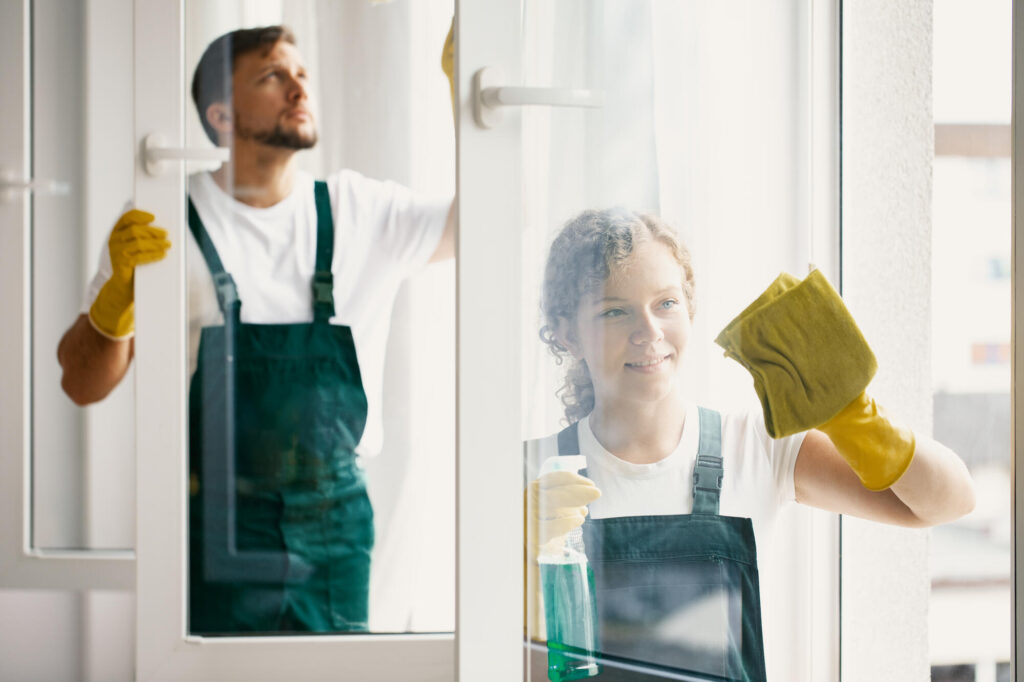Learning how to wash pillows properly is essential for maintaining a clean, healthy, and comfortable sleep environment. While you probably wash your sheets and pillowcases often, the pillows underneath also need attention. Many people ask, “can you wash pillows?” And the answer is yes, but the right method depends on the material and type.
Clean, fresh pillows are key to restful sleep and long-term comfort. Understanding how to clean pillows helps eliminate dust mites, allergens, and bacteria that build up over time. Regular washing pillows not only extends their lifespan but also improves air quality and reduces the risk of skin irritation or allergies. In this guide, Yorleny’s Cleaning Services shares expert advice on how to wash pillows in washing machines, when to avoid machine cleaning, and how to maintain their freshness in Florida’s humid climate.
Why Washing Your Pillows Matters
Health Benefits of Washing Pillows Regularly
Most people don’t realize that pillows can harbor sweat, oil, saliva, dust, bacteria, and even mold. Over time, this buildup damages the filling and reduces support. Washing pillows regularly helps eliminate these contaminants, promoting better hygiene and preventing issues like acne, asthma, and congestion. Clean pillows also create a more comfortable, allergen-free environment for quality sleep.
How Florida’s Humidity Impacts Pillow Hygiene
Florida’s high humidity levels, often above 60%, can make washing pillows even more important. Moisture in the air provides the perfect breeding ground for mold, mildew, and dust mites. Without proper care, pillows can absorb this humidity, resulting in musty odors and potential respiratory issues. Regular cleaning and thorough drying help prevent these problems and keep your bedding fresh and hygienic.
Can You Wash Pillows? Common Questions Answered
Which Types of Pillows Can Be Washed Safely
Feather and Down Pillows
Feather and down pillows are soft, lightweight, and excellent for comfort. However, if you’re wondering “can you put pillows in the washer?”, these types require caution. When washed incorrectly, they can lose their shape or fluff. Use gentle cycles and low heat for drying to preserve volume and softness.
Synthetic Fiber Pillows
Synthetic fiber pillows, usually made of polyester, are the easiest to handle when washing pillows. They resist dust mites and allergens, making them ideal for allergy sufferers. Most synthetic options can be machine washed safely, dry quickly, and maintain their shape well.
Memory Foam Pillows
If you’re exploring how to wash pillows made of memory foam, avoid putting them in the washer. The foam can break apart or lose elasticity. Instead, spot clean with mild detergent and air dry completely to preserve structure and comfort.
Latex Pillows
When learning how to wash pillows, it’s important to note that latex pillows offer firm support and are naturally resistant to mold and dust mites. However, like memory foam, they should not be machine washed. Instead, wipe them with a damp cloth or mild cleaner to avoid deterioration and maintain their durability and comfort.
When Pillows Should Not Go In the Washer
Knowing how to wash pillows correctly also means understanding when not to use a washing machine. Pillows made of memory foam, latex, or those with built-in electronic components should never be machine washed, as agitation and moisture can damage the material or wiring. Always check the care label before cleaning, when in doubt, hand wash or spot clean to prevent damage and keep your pillows in top condition.
Step-by-Step Guide: How to Wash Pillows in the Washing Machine
Preparing Your Pillows for the Wash
Before starting, it’s essential to know how to wash pillows properly to preserve their shape and hygiene. Always inspect the pillow for tears or open seams where the filling could escape during washing pillows. Repair any openings before putting them in the washer. If you spot stains, apply a gentle stain remover, let it sit as instructed, and then continue with the general cleaning process.
Choosing the Right Detergent and Water Settings
Understanding how to wash pillows in washing machine includes selecting the right detergent and settings. Each pillow has a care label with details on whether it’s machine washable, the ideal temperature, and the proper cycle. Warm water and a gentle cycle are generally recommended, but always verify based on the material. Following these steps ensures your pillows remain soft and last longer.
Best Drying Methods to Keep Pillows Fluffy
Once you know how to wash pillows, proper drying is key to preventing mold and maintaining fluffiness. Fiber pillows can be tumble-dried on low heat or air-dried, adding wool or dryer balls to help retain shape. Memory foam pillows should air-dry in a ventilated space away from direct sunlight. Using pillow protectors or waterproof covers also helps extend freshness and prevent odor buildup.
How to Wash Different Types of Pillows
Washing Feather and Down Pillows
If you’re wondering how to wash pillows filled with feathers or down, the answer is yes, with care. Use a mild detergent for delicate fabrics and avoid bleach or softeners that can damage the filling. Opt for lukewarm water and a gentle cycle, ensuring the pillow is rinsed thoroughly to remove any residue. Dry on low heat, adding tennis or dryer balls to help restore volume.
Cleaning Memory Foam and Synthetic Pillows
Synthetic fiber pillows can usually be cleaned on a normal cycle using mild detergent, but always read the label first. After washing pillows, dry them on a low or medium setting and fluff afterward to keep their shape. Memory foam, however, should not be machine washed, water can damage its structure. Instead, wipe stains with a damp cloth and mild cleaner, air out regularly, and use a cover to minimize deep cleanings.
Tips to Keep Pillows Fresh Between Washes
Using Protective Pillow Covers
Use washable pillowcases that add a barrier against dust and sweat, keeping the inside of the pillow in better condition. Similarly, refreshing fabric sprays containing essential oils like lavender or eucalyptus provide a light fragrance and have antimicrobial properties to keep your pillows clean and fresh. An easy step that complements how to wash pillows effectively.
How to Air Out and Maintain Pillows in Humid Climates
In addition to washing them regularly, you can air them out daily and sprinkle baking soda on the surface of the pillow, letting it sit for a few minutes before vacuuming. This helps neutralize odors and moisture, and keeps your pillows white. You can also take advantage of sunlight by exposing them to it for a few hours now and then, as the sun is a natural disinfectant that helps reduce humidity and eliminate bacteria.
When to Replace Your Pillows Instead of Washing Them
Signs Your Pillows Need Replacing
If your pillow has lost its shape and support, shows obvious lumps, stains, or tears, and you wake up with a neck or back ache, those are signs that you should replace it. Other markers include persistent odors, increasing allergy problems, and the need to frequently alter the cushion to achieve comfort. Even if you know how to wash pillows properly, some eventually lose their structure and must be replaced.
You can use the fold test to determine if your pillow needs to be replaced. Fold the pillow in half, hold it for about 30 seconds, and then release. If the pillow does not spring back into its former shape, the fibers are worn and you may need a new one.
How Often to Buy New Pillows for Better Sleep
You should replace your pillow every one to two years for better sleep, as they lose support and can house allergens, dust mites, and bacteria over time. The exact replacement timeline varies by material: polyester/fiberfill pillows normally last 12-18 months, down/feather pillows can last up to two years, and memory foam/latex pillows can last for 2-4 years with good care.
Keep Your Bedroom Fresh and Allergen-Free
Clean Surrounding Areas to Support Pillow Freshness
Learning how to wash pillows is only part of maintaining a clean, healthy sleep environment. Dust, pet dander, and other allergens can settle on nearby surfaces, so make sure to wipe down nightstands, vacuum under the bed, and wash bedding regularly. This extra care helps extend your pillows’ freshness and supports better air quality.
Maintain a Regular Bedroom Cleaning Schedule
Consistency is key to a comfortable and hygienic sleep space. By setting a routine, such as washing pillowcases weekly and deep-cleaning pillows every few months you’ll enjoy a fresher bed and a more relaxing rest. Pair your knowledge of how to wash pillows with a structured cleaning plan to keep allergens under control.
Choose Eco-Friendly Cleaning Products for a Healthier Sleep Space
When refreshing your bedroom, opt for non-toxic, eco-friendly products that are gentle on fabrics and safe for your health. Natural cleaners reduce exposure to harsh chemicals while still delivering effective results. This sustainable approach ensures that your entire bedroom, not just your pillows, stays clean and healthy.
Want a truly fresh, allergen-free bedroom? Trust the experts at Yorleny’s Cleaning Services for professional home cleaning in South Florida. Their eco-friendly approach helps you maintain spotless, comfortable spaces, so you can sleep better every night.
FAQs About How to Wash Pillows
Why is it important to wash your pillows regularly?
Washing pillows on a regular basis removes allergens, bacteria, and body oils, improving cleanliness and potentially preventing health problems. Washing also removes dirt, dust mites, and sweat, which can assist to restore the pillow’s fluffiness and comfort.
Can all types of pillows be washed in the machine?
No, not all pillows can be machine washed; synthetic, down, and feather-filled pillows are frequently machine washable; however, memory foam and latex pillows should not be machine washed since they can be damaged. Always consult the pillow’s care label for precise directions before cleaning.
How often should I wash my pillows?
Most pillows should be washed at least twice a year to eliminate sweat, skin cells, and dust mites. If you sweat a lot, dine in bed, have dogs, or suffer from allergies, you should wash more frequently, every three to four months. Wash your pillowcases weekly to keep the pillow cleaner for longer.
Recent Articles

Thanksgiving Day Checklist 2025: Your Ultimate Guide to Stress-Free Hosting
The Thanksgiving Day checklist is your best ally for a stress-free celebration. Thanksgiving is just around the corner, and nothing says “welcome”…

Turkey Grease Stain Removal: Quick & Effective Cleaning Tips
Have you ever found a special garment or tablecloth with a stubborn grease stain? This is typical after the holidays, when food…

Top Move In and Move Out Cleaning Services for Your Peace of Mind
Hiring move in and move out cleaning professionals is the easiest way to save time, reduce stress, and make sure every space…
An overview of the areas we serve
See below to check if our top-quality house cleaning services are available in your city and book your first appointment with just a few clicks.
